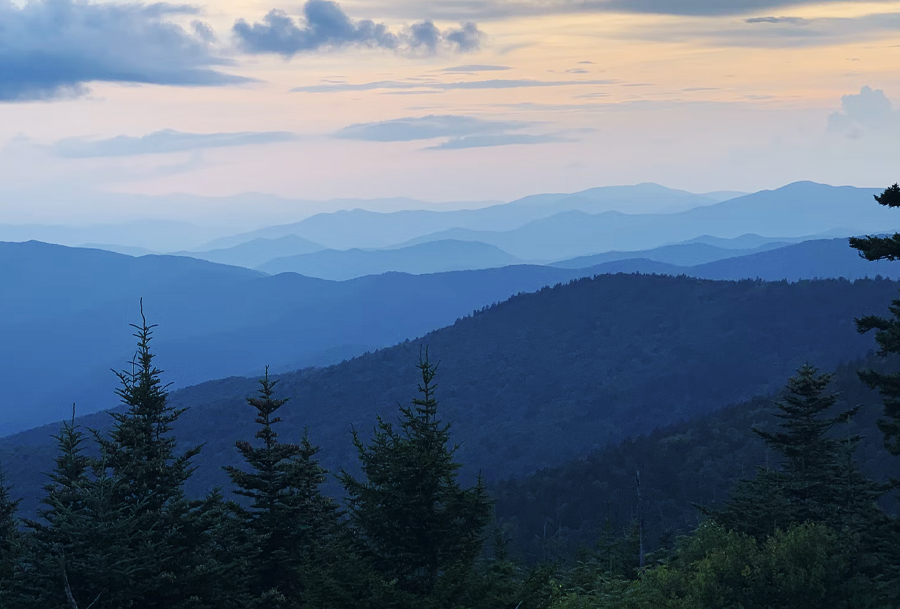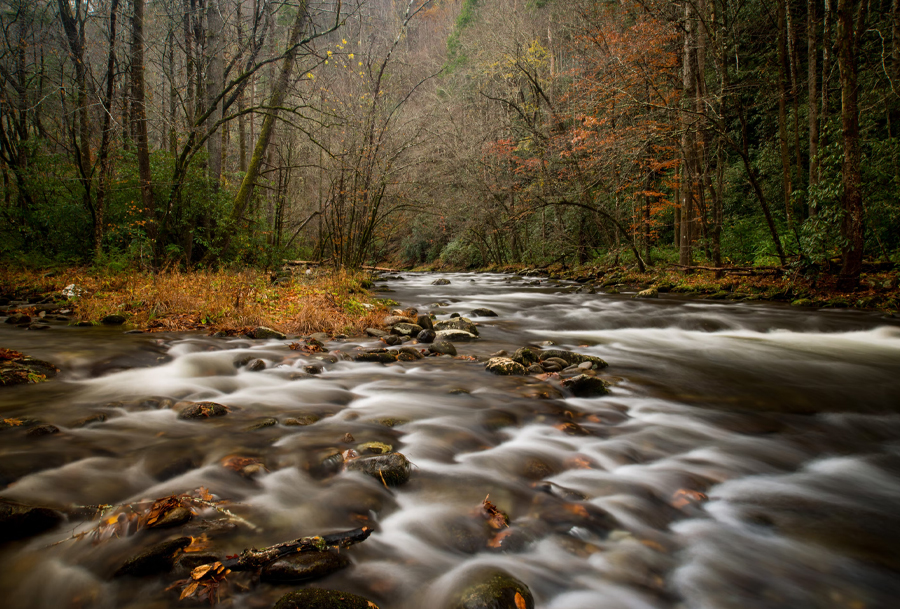
Guide To Great Smoky Mountains National Park

Great Smoky Mountains is the most visited and one of the most beloved National Parks in the United States. Jagged mountain peaks and lush forests give way to tumbling waterfalls in this park that is brimming with adventure. The park is spread across Tennessee and North Carolina and encompasses over 500,000 protected acres. This guide to Great Smoky Mountains National Park will help you to plan your perfect mountain adventure.
History Of Great Smoky Mountains National Park
By the late 1920s, the National Park Service was itching to establish a park east of the Mississippi, and the Smoky Mountains were the perfect location. The park was established in the depths of the Great Depression and it was only made possible by the local community and wealthy philanthropist John D. Rockefeller Jr, who together helped spare the Smokies from further deforestation. You’ll quickly understand that for much of Great Smoky Mountains National Park time has seemingly stood still, when you reach Cades Cove you will be instantly transported to the past.
Visiting Great Smoky Mountains National Park
There are 2 main gateways to the Great Smoky Mountains, on the Tennessee side of the park, you will enter through the Sugarlands Visitor Center near Gatlinburg. And on the North Carolina side of the park, you enter through the Oconaluftee Visitor Center near Cherokee, NC. Between the two entrances, you will find the beautiful Newfound Gap Road which gives you stunning mountain views around every corner.
Great Smoky Mountains National Park Highlights
Hiking
One of the great draws of the Smokies is the extensive trail system that covers the forested valleys and misty mountains of the park. There are over 800 miles of trails in the Great Smoky Mountains and they range from easy rambles to challenging day hikes. If you are really into adventure consider taking a multi-day trek and staying at one of the backcountry campsites. Some of the most popular hikes in the park include:
Gatlinburg Trail
- Distance: 3.9 miles
- Rating: Easy
- Elevation Gain: 164 ft
This quiet and serene trail is right on the edge of bustling Gatlinburg. It is also one of the few dog-friendly trails in the park, but make sure to keep the pup on a 6 ft leash at all times. This easy trail is great for all skill levels and is paved or gravel for easy rambling.

Clingmans Dome Observation Tower Trail
- Distance: 1.2 miles
- Rating: Moderate
- Elevation Gain: 331 ft
This is one of the most popular trails in Great Smoky Mountains National Park. This moderate trail leads you to the highest point in Tennessee, the Clingmans Dome Observation Tower. The peak is 6,634 ft so it’s a good idea to dress warmly no matter the time of year.
Alum Cave To Mount Leconte Trail
- Distance: 10.9 miles
- Rating: Challenging
- Elevation Gain: 2,896 ft
The rewards are great for this challenging hike as you’ll get incredible views, cave exploration, and a very well-maintained trail that makes this 10-mile hike a bit more enjoyable. You’ll begin with a climb along Alum Cave Creek and by mile 2.3 you will arrive at the gorgeous Inspiration Point. Shortly after you’ll find yourself at Alum Cave. This hike is very popular and a great option for intermediate or advanced hikers looking for a challenge.
Waterfalls
There are an impressive 40+ waterfalls in the Smokies. The Smoky Mountains have all the right ingredients to create gorgeous waterfalls including just the right amount of rainfall and an elevation gradient. The abundant rainfall at higher elevations trickles and rushes down the mountainsides, sometimes dropping over a mile in elevation from the high peaks to the foothills creating beautiful waterfalls all over the park. Some of the most popular waterfall hikes in the park include:
Laurel Falls
- Distance: 2.4 miles
- Rating: Easy
- Elevation Gain: 396 Ft
Grotto Falls
- Distance: 2.6 miles
- Rating: Moderate
- Elevation Gain: 544 ft
Rainbow Falls
- Distance: 5.1 miles
- Rating: Difficult
- Elevation Gain: 1,617
Visiting Cades Cove
Cades Cove is one of the most popular destinations inside of Great Smoky Mountains National Park. As one of the most visited spots, you can imagine the crowds that this lush valley draws daily. The 11-mile one-way loop road circles the cove and can take between 2 to 4 hours to complete. You can rent a bike and ride the entire length of the loop road to get a real feel for what it must have been like in the past. Check out as many of the old buildings as you can and don’t forget to stop at the Visitors Center to see the working Grist Mill. This is also the premier spot for wildlife viewing and chances are if you are going to see a black bear in the Great Smokies Mountains that it will be in Cades Cove.

Learning More About The Appalachian History
You can learn more about the history of Appalachia and the Smokies by visiting Cades Cove where you can see a working grist mill, numerous old houses, barns, and churches. Make sure that you don’t miss the Noah “Bud” Ogle Cabin or the Elkmont Historic District. Elkmont is a bit of a hidden gem but it’s a great way to experience the history of the park.
Driving Roaring Forks Motor Nature Trail
This drivable nature trail is a 5.5 mile, one-lane, one-way route that can be enjoyed from the comfort of your vehicle. The motor nature trail gets its name from an exuberant mountain stream. That’s right, the entire nature trail follows the Roaring Forks Stream. Roaring forks is one of the largest and fastest-moving streams in the park. This is another great place for spotting wildlife in the park.
Best Time To Visit the Great Smoky Mountains
The park is open year-round and off-season is considered from late October through May. During the off-season 7 of the 10 park campgrounds are closed as well as many of the visitor centers and guest services.
Winter – The winter season brings the beauty of snow to the higher elevations of the park and with that comes solitude. The park can be very busy during peak seasons, but in the winter you’ll feel like you have the entire park all to yourself. If you plan to hike, bring crampons with you for ice and snow.
Spring – The gorgeous flowers of the Smokies bloom during the spring season. Most of the flowers in the park begin blossoming sometime between the middle of April and the middle of May. Every April the park celebrates the Spring Wildflower Pilgrimage.
Summer – Peak season at Great Smoky Mountains National Park brings warmer temperatures and throngs of visitors to the park. Be prepared for trailheads to be filled by mid-morning and for campgrounds to be fully booked in advance.
Fall – Cooler temperatures and beautiful colors draw large crowds to the Smokies in the fall. You’ll find that the animals that call the park home are much more active during the fall season. Keep your eyes open for both elk and black bear during this time of year.

Where To Stay At Great Smoky Mountains National Park
Camping
There are a total of 10 campgrounds inside the park and they range in price from $17 – $24 a night. The campgrounds offer no-frills amenities such as flush toilets and potable water, but there are no hookups for campers and RVs inside the park. You can make advanced reservations at Recreation.gov.
There are also 98 backcountry campsites in Great Smoky Mountains National Park including 5 that are only accessible by boat. There is a nightly fee of $4 per person for the backcountry sites.
LeConte Lodge
The LeConte Lodge has been operating in the Great Smoky Mountains since 1926 and offers 60 guest rooms. Perched atop the Smokies on the third tallest peak in the park you’ll find this gem that is inaccessible by car. That view is in high demand and you’ll need to book the LeConte Lodge in advance. Oh, and you’ll need to use one of the 5 trails that lead to the lodge to get there. Don’t expect luxury and frills here either, the lodge has remained untouched by time and has rustic touches like washbasins and kerosene lanterns.
Things To Know
There is no entrance fee at Great Smoky Mountains National Park.
The park is very accessible and there are roads that will take you through most areas of the park.
Some of the most popular roads in the park are 441, Newfound Gap Road, and Cades Cove Loop Road. Expect significant traffic on these roads in the peak seasons.
Being the most visited park in the United States means that there will be crowds no matter when you visit. While there may be crowds, the park’s unique setup means that it never feels overly crowded.
If you are looking for elk you will only find them on the North Carolina side of the park. Keep your eyes open anytime you are near the Oconaluftee Visitor Center. The elk are known to frequent the large fields around that area.
Great Smoky Mountains National Park is such a great park to visit at any time of the year. It’s easily accessible to most of the country and you can’t beat those beautiful mountain views and waterfalls.



